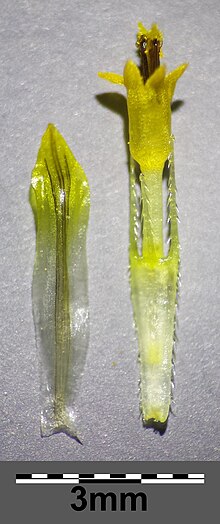Nodding two-tooth
| Nodding two-tooth | ||||||||||||
|---|---|---|---|---|---|---|---|---|---|---|---|---|

Nodding two-toothed tooth ( Bidens cernuus ) |
||||||||||||
| Systematics | ||||||||||||
|
||||||||||||
| Scientific name | ||||||||||||
| Bidens cernua | ||||||||||||
| L. |
The nodding two-toothed tooth ( Bidens cernuus ) is a species of the sunflower family (Asteraceae).
description
The nodding bizarre grows as an annual herbaceous plant and reaches a height of 10 to 90 cm. The stem is erect and often yellow-green in color. The leaves are elongated, lanceolate, undivided and fused together in pairs at the base. They are sharply serrated, light green, glabrous, or sometimes a little hairy on top.
The individual flower heads have a diameter of about 30 mm. They begin to “nod”, especially when they fade. The bracts are arranged in two rows, the outer ones are leaf-like and much longer than the inner ones. These are broadly ovate and brown-green in color. The chaff leaves are as long as the fruit and awns. The ray florets are yellow in color, if present, but can often be absent. The tubular flowers are more golden yellow in color.
The achenes are three to four-sided in cross-section and have four awns .
The flowering period extends from July to September. The number of chromosomes is 2n = 24.

Occurrence
Bidens cernuus occurs in Europe, across the Balkans to North and East Asia and in North America. It is a Eurasian-continental floral element.
It occurs scattered to widespread throughout Germany. In the Alps, it rises to an altitude of 800 meters. In Austria and Switzerland the species occurs absent-minded.
The nodding two-toothed tooth grows in bank communities, on ditches, ponds, in swamps, bogs and on moist fields. It prefers wet, nutrient and nitrogen-rich mud and clay soils. In Central Europe it is a character species of the association Bidention tripartitae and often occurs in the company of the Ranunculetum scelerati.
Common names
The other German-language trivial names exist or existed for the nodding Zweizahn, sometimes only regionally : Busemannsförke ( Unterweser , East Friesland ), Kunigendkraut, Wiesen-Stup ( Pomerania ) and Zeguneleis ( Transylvania ).
swell
literature
- Henning Haeupler, Thomas Muer: picture atlas of the fern and flowering plants of Germany . Ed .: Federal Agency for Nature Conservation (= The fern and flowering plants of Germany . Volume 2 ). Eugen Ulmer, Stuttgart (Hohenheim) 2000, ISBN 3-8001-3364-4 .
- Wolfgang Adler, Karl Oswald, Raimund Fischer: Excursion flora of Austria . Ed .: Manfred A. Fischer. Eugen Ulmer, Stuttgart / Vienna 1994, ISBN 3-8001-3461-6 .
- Christian Heitz: School and excursion flora for Switzerland. Taking into account the border areas. Identification book for wild growing vascular plants . Founded by August Binz. 18th completely revised and expanded edition. Schwabe & Co., Basel 1986, ISBN 3-7965-0832-4 .
- Erich Oberdorfer : Plant-sociological excursion flora . With the collaboration of Theo Müller. 6th, revised and expanded edition. Eugen Ulmer, Stuttgart (Hohenheim) 1990, ISBN 3-8001-3454-3 .
- Konrad von Weihe (ed.): Illustrated flora. Germany and neighboring areas. Vascular cryptogams and flowering plants . Founded by August Garcke. 23rd edition. Paul Parey, Berlin / Hamburg 1972, ISBN 3-489-68034-0 .
Individual evidence
- ↑ a b Erich Oberdorfer : Plant-sociological excursion flora for Germany and neighboring areas . With the collaboration of Angelika Schwabe and Theo Müller. 8th, heavily revised and expanded edition. Eugen Ulmer, Stuttgart (Hohenheim) 2001, ISBN 3-8001-3131-5 , pp. 929 .
- ^ Bidens in the Germplasm Resources Information Network (GRIN), USDA , ARS , National Genetic Resources Program. National Germplasm Resources Laboratory, Beltsville, Maryland. Retrieved March 12, 2018.
- ^ Georg August Pritzel , Carl Jessen : The German folk names of plants. New contribution to the German linguistic treasure. Philipp Cohen, Hannover 1882, p. 59, online.
Web links
- Nodding two-tooth. In: FloraWeb.de.
- Nodding two-tooth . In: BiolFlor, the database of biological-ecological characteristics of the flora of Germany.
- Profile and distribution map for Bavaria . In: Botanical Information Hub of Bavaria .
- Bidens cernua L. In: Info Flora , the national data and information center for Swiss flora .
- Distribution in the northern hemisphere from: Eric Hultén, Magnus Fries: Atlas of North European vascular plants. 1986, ISBN 3-87429-263-0 at Den virtuella floran. (swed.)
- Thomas Meyer: Zweizahn data sheet with identification key and photos at Flora-de: Flora von Deutschland (old name of the website: Flowers in Swabia )




